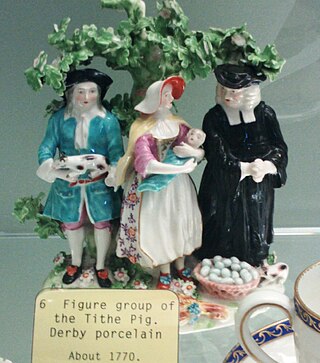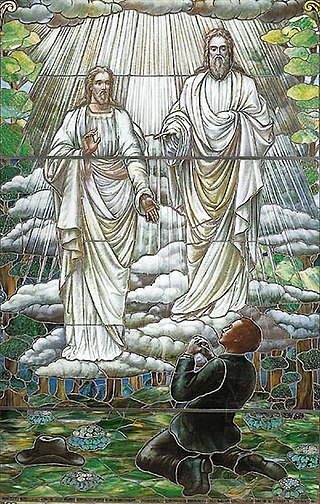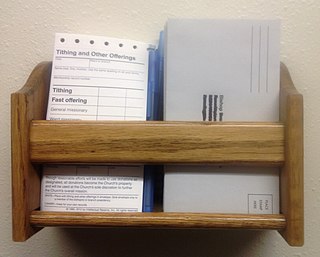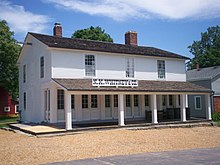
The Church of Jesus Christ of Latter-day Saints, informally known as the LDS Church or Mormon Church, is a restorationist, nontrinitarian Christian denomination belonging to Mormonism. The church is headquartered in the United States in Salt Lake City, Utah and has established congregations and built temples worldwide. According to the church, it has over 17 million members and 62,544 full-time volunteer missionaries. Based on these numbers, the church is the fourth-largest Christian denomination in the United States as of 2012, and reported over 6.8 million US members as of 2022.

Mormonism is the religious tradition and theology of the Latter Day Saint movement of Restorationist Christianity started by Joseph Smith in Western New York in the 1820s and 1830s. As a label, Mormonism has been applied to various aspects of the Latter Day Saint movement, although there has been a recent push from the Church of Jesus Christ of Latter-day Saints to distance themselves from this label. A historian, Sydney E. Ahlstrom, wrote in 1982, "One cannot even be sure, whether [Mormonism] is a sect, a mystery cult, a new religion, a church, a people, a nation, or an American subculture; indeed, at different times and places it is all of these."

A tithe is a one-tenth part of something, paid as a contribution to a religious organization or compulsory tax to government. Today, tithes are normally voluntary and paid in cash or cheques or more recently via online giving, whereas historically tithes were required and paid in kind, such as agricultural produce. After the separation of church and state, church tax linked to the tax system are instead used in many countries to support their national church. Donations to the church beyond what is owed in the tithe, or by those attending a congregation who are not members or adherents, are known as offerings, and often are designated for specific purposes such as a building program, debt retirement, or mission work.
The status of women in Mormonism has been a source of public debate since before the death of Joseph Smith in 1844. Various denominations within the Latter Day Saint movement have taken different paths on the subject of women and their role in the church and in society. Views range from the full equal status and ordination of women to the priesthood, as practiced by the Community of Christ, to a patriarchal system practiced by the Church of Jesus Christ of Latter-day Saints, to the ultra-patriarchal plural marriage system practiced by the Fundamentalist Church of Jesus Christ of Latter-Day Saints and other Mormon fundamentalist groups.
In the Latter Day Saint movement, the United Order was one of several 19th-century church collectivist programs. Early versions of the Order beginning in 1831 attempted to fully implement the law of consecration, a form of Christian communism or communalism, modeled after the New Testament church which had "all things in common". These early versions ended after a few years. Later versions within Mormonism, primarily in the Utah Territory, implemented less-ambitious cooperative programs, many of which were very successful. The Order's full name invoked the city of Enoch, described in Latter Day Saint scripture as having such a virtuous and pure-hearted people that God had taken it to heaven.
In the Latter Day Saint movement, a bishop is the highest office of the Aaronic priesthood. It is almost always held by one who holds the office of high priest in the Melchizedek priesthood. The Latter Day Saint concept of the office differs significantly from the role of bishops in other Christian denominations, being in some respects more analogous to a pastor or parish priest. Each bishop serves with two counselors, who together form a bishopric.
Fast offering is the term used in the Church of Jesus Christ of Latter-day Saints to denote money or usable commodities donated to the church, which are then used to provide financial or other assistance to those in need. The local bishop or branch president is responsible for the use of the fast offering resources, and is usually assisted by other local church leaders to identify individuals and families to receive assistance and to disburse the resources.

Latter-day Saint Charities is a branch of the welfare department of the Church of Jesus Christ of Latter-day Saints. The organization's stated mission is to relieve suffering, to foster self-reliance for people of all nationalities and religions, and to provide opportunities for service.
The law of consecration is a commandment in the Latter Day Saint movement in which adherents promise to dedicate their lives and material substance to the church. It was first referred to in 1831 by Joseph Smith.

The Apostolic United Brethren (AUB) is a Mormon fundamentalist group that practices polygamy. The AUB has had a temple in Mexico, since at least the 1990s, an endowment house in Utah since the early 1980s and several other locations of worship to accommodate their members in Wyoming, Arizona, and Montana.

The finances of the Church of Jesus Christ of Latter-day Saints (Church) are not a matter of public record. In the absence of official statements, people interested in knowing the Church's financial status and behavior, including both members of the Church and others, have attempted to estimate or guess. According to the Church, their funding comes from the donations of its members and the principal expense is in constructing and maintaining facilities.
The General Handbook: Serving in The Church of Jesus Christ of Latter-day Saints is an on-line book of instructions and policies for leaders and members of the Church of Jesus Christ of Latter-day Saints. The contents are prepared by the church's First Presidency and Quorum of the Twelve Apostles. Along with the church's standard works, the General Handbook stands as the preeminent policy and practice guide for the leaders of the LDS Church.
Gérald Jean Caussé has been the Presiding Bishop of the Church of Jesus Christ of Latter-day Saints since 9 October 2015. He is the fifteenth man to serve in this position. He has been a general authority of the LDS Church since 2008 and was the first person from France appointed as a general authority.

The Church of Jesus Christ of Latter-day Saints focuses its doctrine and teaching on Jesus Christ; that he was the Son of God, born of Mary, lived a perfect life, performed miracles, bled from every pore in the Garden of Gethsemane, died on the cross, rose on the third day, appeared again to his disciples, and now resides, authoritatively, on the right hand side of God. In brief, some beliefs are in common with Catholics, Orthodox and Protestant traditions. However, teachings of the LDS Church differ significantly in other ways and encompass a broad set of doctrines, so that the above-mentioned denominations usually place the LDS Church outside the bounds of orthodox Christian teaching as summarized in the Nicene Creed.
Islam and Mormonism have been compared to one another since the earliest origins of the latter in the nineteenth century, sometimes by detractors of one or both religions, but also at least once by Joseph Smith, founder of the Latter Day Saint movement, himself. Smith was also frequently referred to as "the Modern Muhammad" by several publications of the era, notably in the New York Herald, shortly after his assassination in June 1844. This epithet repeated a comparison that had been made from Smith's earliest career, one that was not intended at the time to be complimentary.

Welfare Square is a complex in downtown Salt Lake City, Utah owned and operated by the Church of Jesus Christ of Latter-day Saints, to provide material assistance to poor and otherwise needy individuals and families. Welfare Square is part of the Church's Church Welfare System. It includes a 178-foot (54 m) grain silo, fruit orchards, a milk-processing plant, a cannery, a bakery, a Deseret Industries thrift store, a private employment office, and the LDS Church's largest Bishop's storehouse, as well as associated administrative offices.

Tithing is a commandment accepted by various churches in the Latter Day Saint movement. In practicing tithing, adherents make willing tithe donations, usually ten percent of their income, to their church. It is based on both the biblical practice of paying tithes and modern revelation given to Joseph Smith and his accepted successors. For many of these churches, the law of tithing replaced or supplemented the law of consecration. The Church of Jesus Christ of Latter-day Saints emphasized tithing in the 1900s and 1960s to assist in paying church debts.

Philanthropies, formerly LDS Philanthropies, is a department of the Church of Jesus Christ of Latter-day Saints and is responsible for facilitating donations to humanitarian and educational initiatives. The department works under the direction of the church's Presiding Bishop. The most widely known educational projects are the operation of church-owned schools, such as Brigham Young University (BYU). Humanitarian funds are given to Latter-day Saint Charities which sponsors and organizes relief efforts. In 2019, the church reported over 3,000 community-based projects with an excess of 2,000 partners, in locations around the world. A 2020 statistic reported a total of $2.3 billion that had been donated over Philanthropies' existence.

Tithing buildings of The Church of Jesus Christ of Latter-day Saints are storehouses related to tithing by members of the Church of Jesus Christ of Latter-day Saints.












